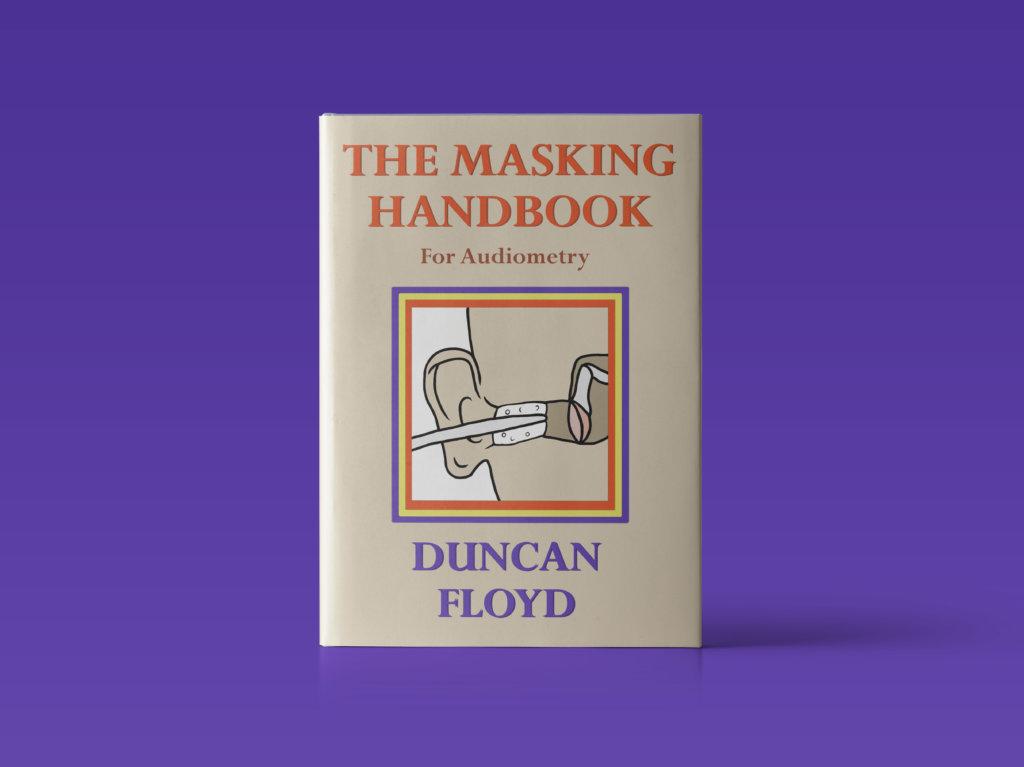Book Review
The Masking Handbook (For Audiometry)

By Duncan Floyd
Reviewed by Joshua Creppin, M.Sc., Audiologist, Reg. CASLPO
This is the book I wish I had as an audiology student. Masking is perhaps a more intimidating and challenging concept to learn when beginning audiometry. As the author notes, masking is a topic with significant variability in theory and practice. It can potentially lead you down a rabbit hole of confusion, with differing methodologies and terminology used from various sources. This is where The Masking Handbook shines; it accumulates the latest concepts and time-tested evidence and strategies and presents them to the reader in a clear, concise, and sensible manner. It also challenges some assumptions and norms currently used in masking, supporting these challenges with research-based evidence and suggestions.
Although this handbook requires some basic understanding of audiometry and hearing assessments before reading, it is designed for both new learners and as a quick reference guide for hearing practitioners. The handbook is written in casual (Canadian) English, to make it as clear as possible, and the handbook delivers in this regard. Whenever jargon is used in the handbook, it is defined beforehand so that the reader is not at risk of being left confused by terminology. There is also an appendix with acronyms and definitions if the reader requires further clarification. The handbook is sprinkled with applaudable humour throughout, supplying a much-needed laugh while trying to tackle a historically dry topic.
Structurally, chapters in the handbook are clearly laid out to find the desired information easily. The first few chapters of the handbook provide the background information and theory required to understand concepts in masking. The bulk of the handbook covers different masking methods that can and should be used in a clinical setting, primarily in the context of testing adults. It details the main considerations needed for masking: when masking is required, appropriate terminology, theory on different masking techniques, recommended starting masking levels, efficient methods to save time in clinic, and how to troubleshoot when masking becomes more challenging. Equally important, the author is fully transparent about existing limitations in knowledge on the subject, even among well-established testing procedures such as speech masking and attenuation values. As a result, the handbook encourages reflection on one’s own methodology and practices; an essential exercise for clinicians to continue to think critically even as they gain further experience.
From the opening chapter of this handbook, the author stresses the importance of supplementing learning with practical experience. To that end, key values and formulae are provided in the appendices, which may be easily accessed or printed and kept near the audiometer for quick referencing in the clinic. Whenever the handbook recommends practical use, such as attenuation before cross-over, the benefit of insert earphones, or initial masking levels, it backs up the assertion with logical and evidence-based reasoning. The handbook encourages the clinician to think critically when things go awry (i.e., the masking dilemma), and when it comes to masking, things will eventually go awry! The author provides the reader with the tools necessary to understand the concepts and to apply efficient solutions in their everyday practice.
The Masking Handbook will primarily benefit students who are learning masking and may be confused. That said, there is much to be gained for a clinician with years of experience to read this handbook. I strongly encourage seasoned practitioners to read the discussion on Robert Turner’s Optimized Method of Masking, which can be a huge time-saver in the clinic. Other topics, such as speech-test masking and the occlusion effect, contain information and methodologies that may be new or of interest to experienced clinicians. More than anything, the clarity of this handbook makes masking in audiometry more digestible.
One aspect that separates this handbook from other similar texts is its multi-modal approach to learning. This handbook provides various learning methods to accommodate a variety of learning strategies. The handbook is also available in both print and e-book format. With clear text and images throughout, every key topic is supplemented with links to accessible learning videos in the e-book format, and it even provides key masking concepts in a mathematical equation-type format.
The Masking Handbook is quite concise at just under 200 pages and could easily be read within a day. However, I recommend spreading it out over multiple days as there is a lot of valuable information that is worthy of thorough consideration. Although The Masking Handbook does not extensively cover masking among pediatric cases or proper masking in ABR testing, it is comprehensive in all other aspects. It succeeds in bridging the gap between the classroom and real-world practice. I commend the author for tackling such a daunting topic and turning it into a wonderful handbook for students first learning about masking and as a reference source for experienced clinicians wanting to brush up on masking and learn new, evidence-based information. I have certainly learned a thing or two (or three) myself!

